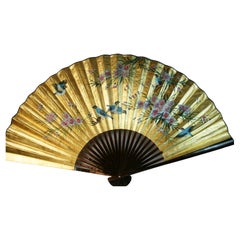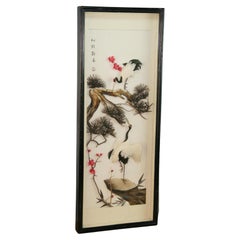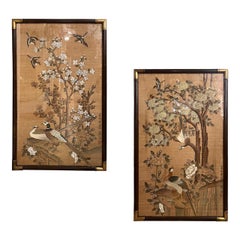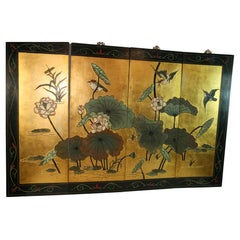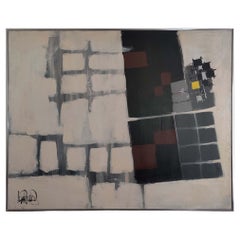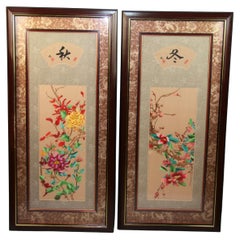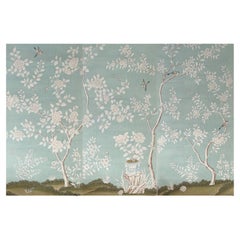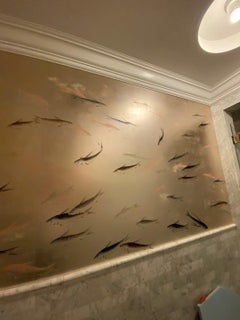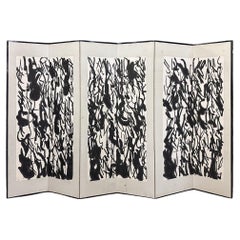1960s Paintings and Screens
to
3
16
4
29
2
1
172
682
913
150
315
195
107
38
4
33
14
12
25
29
28
26
8
18
15
10
8
5
19
17
14
2
2
29
29
29
9
1
1
1
1
Period: 1960s
Vintage Chinese Large Hand Painted Birds and Flowers Fan/ Screen
Located in Douglas Manor, NY
1746 Vintage Chinese hand painted oversized fan / screen with colorful flowers and blue birds
Folded size 45x4x3"
Category
Vintage 1960s Paintings and Screens
Materials
Bamboo, Paint, Paper
Asian Egret Large Diorama
Located in Douglas Manor, NY
3-941 Hand made diorama using bird feathers and natural fauna set in a lacquered wood frame under glass.
Category
Vintage 1960s Paintings and Screens
Materials
Hardwood, Feathers
$875 Sale Price
37% Off
Pair of Painted Chinoiserie Panels
Located in New York, NY
Pair of 1960s painted panels depicting trees and birds.
Measurements:
Height: 44"
Width: 26.25".
Category
Chinese Vintage 1960s Paintings and Screens
Materials
Wood
$4,800 / set
Asian Four Individual Panel Wall Screen With Embossed Birds and Flowers
Located in Douglas Manor, NY
1763 Four individual embossed hand painted wall panels/screen
each panel 14x36"
Birds and flowers
Category
Vintage 1960s Paintings and Screens
Materials
Hardwood
Large Scale Signed Lee Reynolds Abstract Oil Painting Mid-Century Modern 1960s
By Lee Reynolds
Located in Philadelphia, PA
A very large and super cool, 1960s, oil on canvas abstract painting signed by Lee Reynolds. Colors are white, gray, brown, black and yellow. 49" tall x 61" wide, with the original po...
Category
American Mid-Century Modern Vintage 1960s Paintings and Screens
Materials
Canvas, Paint
Pair Chinese Silk Foral Panels
Located in Douglas Manor, NY
Pair silk floral panels set in wood frames
each panel 22 x 47"
Combined panels 44" x 47".
Category
Vintage 1960s Paintings and Screens
Materials
Silk, Hardwood
$975 Sale Price / set
45% Off
Moon and Blossoms Hand Painted Scroll
Located in Douglas Manor, NY
Hand painted scroll of moon and flower blossoms
Will be shipped rolled up
Size 28 x 72" open
28 x 3" rolled up.
Category
Vintage 1960s Paintings and Screens
Materials
Paint, Paper
$232 Sale Price
59% Off
Japanese Two Panel Screen Moon Rising Over Turbulent Ocean Landscape
Located in Hudson, NY
Contemporary sumie (ink) painting on silver.
Category
Japanese Showa Vintage 1960s Paintings and Screens
Materials
Paper
1960s Rattan Screen Panels Room Divider, Set of 2
Located in Fort Lauderdale, FL
On offer on this occasion is one of the most stunning and rare, rattan panels divider set you could hope to find. Outstanding design is exhibited throughout. The beautiful set is sta...
Category
Philippine Mid-Century Modern Vintage 1960s Paintings and Screens
Materials
Rattan
Vintage Japanese Ukiyo-e Print of Kinkaku-ji in Snow by Tokuriki Tomikichiro
By Tokuriki Tomikichiro 1
Located in Philadelphia, PA
A fine vintage Japanese woodblock print.
Entitled "Kinkaku-ji in Snow".
By Tomikichiro Tokuriki (1902 - 1999). Tokuriki came from a...
Category
Japanese Showa Vintage 1960s Paintings and Screens
Materials
Paper
Vietnamese Scene by French Artist J Buttin
Located in Jersey City, NJ
J Buttin was a French artist who lived in Indochina. This painting shows water carrier women under banana leaves. It is signed.. The painting has been recently cleaned by a professio...
Category
French Vintage 1960s Paintings and Screens
Materials
Canvas, Wood
VIntage kimono textile art " Monochrome Geometry " by ikasu Gold, Grey, Japan
By Kimono ikasu
Located in Setagaya City, JP
This work is inspired by traditional Japanese nature colors symbolism, and is framed in paulownia wood originally used for a kimono chest-of-drawers.
It is filled with storytelling ...
Category
Japanese Japonisme Vintage 1960s Paintings and Screens
Materials
Silk, Wood
Vintage kimono textile art "Autumn branches ~ Kintsugi ~" by ikasu Brown, Japan
By Kimono ikasu
Located in Setagaya City, JP
The frame for this work is made of paulownia wood taken from antique Kiritansu - chest-of-drawers for kimono.
I use antique kiritansu that can’t be used as furniture anymore to crea...
Category
Japanese Japonisme Vintage 1960s Paintings and Screens
Materials
Gold Leaf
VIntage kimono textile art "Geometry ~Chrysanthemums" by ikasu, white, red Japan
By Kimono ikasu
Located in Setagaya City, JP
This work is inspired by traditional Japanese natural symbolism, and is framed in paulownia wood originally used for a kimono chest-of-drawers.
It is elegantly framed with paulownia...
Category
Japanese Japonisme Vintage 1960s Paintings and Screens
Materials
Silk, Wood
FiVE CHINESE CH'IEN LUNG PERIOD 1736-1796 WATERCOLOUR BIRD PIANTINGS FRAMED
Located in West Sussex, Pulborough
Royal House Antiques
Royal House Antiques is delighted to offer for sale this lovely suite of five original Watercolour paintings dating to the Ch'ien Lung Period 1736-1796 publishe...
Category
Chinese Chinese Export Vintage 1960s Paintings and Screens
Materials
Paper
VIntage kimono textile art " Wish for prosperity " by ikasu Gold, Black, Japan
By Kimono ikasu
Located in Setagaya City, JP
This work is inspired by traditional Japanese nature colors symbolism, and is framed in paulownia wood originally used for a kimono chest-of-drawers.
It is filled with storytelling ...
Category
Japanese Japonisme Vintage 1960s Paintings and Screens
Materials
Silk, Wood
VIntage kimono textile art "Geometry ~Marble~" by ikasu Gold, White, Grey, Japan
By Kimono ikasu
Located in Setagaya City, JP
This work is inspired by traditional Japanese nature motifs symbolism, and is framed in paulownia wood originally used for a kimono chest-of-drawers.
It is elegantly framed with pau...
Category
Japanese Japonisme Vintage 1960s Paintings and Screens
Materials
Silk, Wood
Vintage kimono textile art "Fern ~Connection to Nature~" by ikasu Black , Japan
By Kimono ikasu
Located in Setagaya City, JP
This work uses an antique tomesode (festive kind of kimono) with fern design to evoke feelings of tranquility, harmony, and appreciation for the beauty of the environment. Can be used both vertically and horizontally.
It is elegantly framed with paulownia wood originally used for kimono chest-of-drawers, and is filled with storytelling and sense of luxury.
I used pieces of kimono that could no longer be used as clothing and kiritansu chest-of-drawers that would normally be discarded to create the ultimate upcycled piece.
<< Explanation of colors and patterns >>
In Japanese traditional culture, ferns, particularly the Japanese painted fern (Athyrium niponicum), hold several meanings and symbolisms:
・Elegance and Beauty: Ferns are admired for their graceful, delicate appearance and intricate leaf patterns. In Japanese aesthetics, they are appreciated for their natural beauty and are often used in gardens, landscapes, and floral arrangements to add a sense of refinement and elegance.
・Resilience and Perseverance: Ferns are known for their ability to thrive in diverse environments, including shady forests, rocky cliffs, and damp soil. Their resilience in the face of challenging conditions is seen as a symbol of endurance and perseverance. In Japanese culture, ferns may represent the ability to overcome adversity and flourish despite obstacles.
・Connection to Nature and Tranquility: Ferns are native to forested areas and are often associated with the natural world. In Japanese traditional culture, they symbolize a deep connection to nature and the importance of maintaining harmony with the environment. The lush green foliage of ferns evokes feelings of tranquility and peacefulness, making them popular motifs in Zen gardens and traditional landscape paintings.
・Purity and Simplicity: Ferns are emblematic of simplicity and purity in Japanese aesthetics. Their unassuming beauty and understated elegance reflect the principles of wabi-sabi, an aesthetic worldview that values imperfection, impermanence, and simplicity. Ferns may be used in tea ceremonies, Ikebana (flower arranging), and other traditional arts to evoke a sense of tranquility and appreciation for life's fleeting moments.
Overall, ferns in Japanese traditional culture symbolize elegance, resilience, connection to nature, purity, and simplicity. Their presence in art, literature, and landscape design underscores their enduring significance as symbols of natural beauty and spiritual resonance.
<< Characteristics of the fabric >>
This vintage textile is hand-painted with a traditional Japanese technique called "yuzen".
<< About the frame >>
Kiritansu - chest-of-drawers for kimono, is traditionally made from paulownia wood, a uniquely Japanese material closely tied to the world of kimonos.
Paulownia wood is known as the lightest wood in Japan, prased for its natural luster, resistance to moisture, and resilience against cracking. Since ancient times, it has been used in crafting furniture, chests, and musical instruments.
During the Edo period, it became customary to store cherished kimonos in paulownia chests...
Category
Japanese Japonisme Vintage 1960s Paintings and Screens
Materials
Silk, Wood
Vintage kimono textile art "Marble Story ~ Healing ~" by ikasu Grey, Japan
By Kimono ikasu
Located in Setagaya City, JP
This work uses a vintage kimono fabric with marble pattern, that makes it look like a real piece of marble.
The line in the middle symbolizes “kintsugi” - concept of wabi-sabi, which values imperfection, impermanence, and the beauty of aging.
It is elegantly framed with paulownia wood originally used for kimono chest-of-drawers, and is filled with storytelling and sense of luxury.
I used pieces of kimono that could no longer be used as clothing and kiritansu chest-of-drawers that would normally be discarded to create the ultimate upcycled piece.
<< Explanation and meaning of pattern and colors >>
Kintsugi (金継ぎ), which translates to "golden joinery" or "golden repair," is a traditional Japanese art form of repairing broken pottery with lacquer mixed with powdered gold, silver, or platinum. I used this tecnique here to "repair" antique kimono by transforming it into art work. Beyond its literal meaning of mending broken ceramics, kintsugi carries profound philosophical and cultural significance in Japanese tradition:
・Embracing Imperfection: Kintsugi celebrates imperfection and impermanence. Rather than disguising or concealing flaws, it highlights them, treating the breakage as part of the object's history. This philosophy encourages acceptance of imperfection as an essential aspect of life, beauty, and human experience.
・Wabi-Sabi Aesthetic: Kintsugi embodies the principles of wabi-sabi, an aesthetic worldview centered on the acceptance of transience and imperfection. Wabi-sabi values simplicity, authenticity, and the beauty of things that are imperfect, impermanent, and incomplete. Kintsugi exemplifies these principles by turning what might be considered flaws into features that enhance the object's beauty and character.
・Resilience and Transformation: The act of repairing broken things with precious metals symbolizes resilience and transformation. Instead of discarding or replacing the broken object, kintsugi honors its history and transforms it into something new and valuable. This reflects broader philosophical themes of overcoming adversity, finding beauty in imperfection, and embracing change.
・Honoring the Past: Kintsugi preserves and honors the history of the object. Rather than erasing or ignoring its past, it acknowledges and celebrates it. This aspect of kintsugi can be seen as a metaphor for honoring our own personal histories, including the challenges and setbacks we have faced, and recognizing how they have shaped us into who we are today.
・Spiritual and Philosophical Symbolism: Kintsugi has spiritual and philosophical implications, reflecting concepts such as the interconnectedness of all things, the cycle of life and death, and the pursuit of harmony and balance. The process of repairing broken objects with precious metals is seen as a metaphor for spiritual growth, enlightenment, and the journey towards wholeness.
Overall, kintsugi represents not only a practical technique for repairing ceramics but also a profound philosophical and cultural perspective on life, beauty, and the human experience. It embodies values such as resilience, acceptance, and the transformative power of embracing imperfection.
<< Characteristics of the fabric >>
This vintage textile is hand-painted with a traditional painting technique where the colors are added on wet surface, which creates an effect of marble.
<< About the frame >>
Kiritansu - chest-of-drawers for kimono, is traditionally made from paulownia wood, a uniquely Japanese material closely tied to the world of kimonos.
Paulownia wood is known as the lightest wood in Japan, prased for its natural luster, resistance to moisture, and resilience against cracking. Since ancient times, it has been used in crafting furniture, chests, and musical instruments.
During the Edo period, it became customary to store cherished kimonos in paulownia chests...
Category
Japanese Japonisme Vintage 1960s Paintings and Screens
Materials
Gold Leaf
Vintage kimono textile art "Sunset Timelapse ~Ephemerality~" by ikasu Red, Japan
By Kimono ikasu
Located in Setagaya City, JP
The art piece uses two sides - front and reverse - of the same kimono, to show beautiful sea surrounding Japan, in hues and in late sunset, as a timelapse.
The frame for this work is made of paulownia wood taken from antique Kiritansu - chest-of-drawers for kimono.
I use antique kiritansu that can’t be used as furniture anymore to create basis and frames for my works. It adds them even more authentic atmosphere of traditional wabisabi spirit. Can you feel it?
<< Period / Story >>
The kimono used in this piece was originally crafted during Showa period (around 1960ies).
<< Explanation and meaning of pattern and colors >>
Sea waves, depicted in two color variations here, are a symbol of transience and Impermanence in Japanese culture. The ebb and flow of the tides, the ever-changing currents, and the relentless motion of the waves serve as reminders of the fleeting nature of life. This artwork featuring the sea convey themes of impermanence, reminding viewers to cherish the present moment and appreciate the beauty of life's fleeting moments.
The theme of impermanence is strengthen by two colors of the sea - the lighter in early hues and the darker when the sun is just about to set in the sea.
<< About the frame >>
This artwork frame is crafted from paulownia wood, a uniquely Japanese material closely tied to the world of kimonos, and it serves to convey the refined beauty of Japanese nature.
Paulownia wood is known as the lightest wood in Japan, prased for its natural luster, resistance to moisture, and resilience against cracking. Since ancient times, it has been used in crafting furniture, chests, and musical instruments.
Paulownia wood is closely linked to kimono culture. During the Edo period (17th cent.~), it became customary to store cherished kimonos in paulownia chests...
Category
Japanese Japonisme Vintage 1960s Paintings and Screens
Materials
Silk, Wood
Haku Maki Japanese Woodblock "Poem 69-17" Signed
By Haku Maki
Located in New York, NY
Haku Maki (1924-2000) Japanese Woodblock Poem 69-17. This art is from the Poem collection. Signed and numbered in pencil. Edition 15/86. Color wood blocking with embossing. Measures ...
Category
Japanese Vintage 1960s Paintings and Screens
Materials
Paper
Mythical Balinese Painting in Original Carved Frame by W Rejamus
Located in Godshill, Isle of Wight
Mythical Balinese Painting in Original Carved Frame by W Rejamus
Wonderfull detail and incredibly colourful characters, very well executed, all in all a very interesting piece and s...
Category
Folk Art Vintage 1960s Paintings and Screens
Materials
Teak
Yoshitoshi Mori Signed Original Japanese Asian Watercolor. and Gouache Painting
Located in Studio City, CA
An original gouache and watercolor painting by Japanese artist/master printmaker Yoshitoshi Mori who was famed for his kappazuri stencil printing technique. In the 1950s Mori became ...
Category
Japanese Showa Vintage 1960s Paintings and Screens
Materials
Paint, Paper
Hidetaka Ohno "Red No.2-15", 1964 Oil and Burlap Collage
By Hidetaka Ohno
Located in Sharon, CT
Red No.2-15 by Hidetaka Ohno, signed and dated (1964) verso. Labels from the Yamada Art Gallery, Tokyo, and from The Corcoran Gallery of Art, D.C. stating that this was exhibited as ...
Category
Japanese Brutalist Vintage 1960s Paintings and Screens
Materials
Burlap
1960s Hand-Painted Wood and Porcelain Tabletop Screen
Located in Tarrytown, NY
1960s hand-painted wood and porcelain tabletop screen
Each panel is 5” wide and has prominent colors of blue, green, pink, and yellow.
Category
Vintage 1960s Paintings and Screens
Materials
Porcelain, Wood
Vintage obi textile art " Camellia ~ Serendipity ~ " by ikasu Blue, Japan
By Kimono ikasu
Located in Setagaya City, JP
This work is inspired by traditional Japanese nature motifs symbolism, and is framed in paulownia wood originally used for a kimono chest-of-drawers.
In this artwork, the aim was to capture the the auspicious symbol of camellia used in antique kimono. Traditional Japanese culture, represented by the kimono, and wood, an integral element of Japanese craftsmanship, were used to bring this vision to life.
I used pieces of kimono that could no longer be used as clothing and kiritansu chest-of-drawers that would normally be discarded to create the ultimate upcycled piece.
<< Explanation and meaning of pattern and colors >>
This delicate piece features hand-drawn camellia motifs flowing gracefully on a softly brightened grayish background.
Camellias, native to Japan, bloom from winter to early spring. As an evergreen tree with green leaves throughout the year, it symbolizes the anticipation of spring and is considered an auspicious plant. Due to its seasonal significance and auspicious meanings, camellias have been used as motifs symbolizing good fortune. Additionally, they were highly valued for their use in oil, cosmetics, and medicine, representing nobility. Believed to possess the power to ward off misfortune, camellias also carry the meaning of "protection from calamity" and have strong ties to traditional ceremonies. In this artwork, camellias are delicately depicted alongside flowing branches, subtly representing good fortune with their pale pink and white hues.
"Sora-iro nezumi 空色鼠" refers to a light grayish color with a hint of blue, reminiscent of the slightly brightened sky on a lightly cloudy day. Popular during the late Edo period (19th cent.), it elegantly captures the slightly brighter sky pattern seen on lightly overcast days. Notably, the term "nezumi-iro" (mouse gray), popular during the late Edo period, was paired with brown tones, collectively known as "Forty-eight Teas and a Hundred Mice 四十八茶百鼠." Colors within the "nezumi" (gray) spectrum, particularly "sora-iro nezumi," were favored by young people for their cool and sophisticated appeal.
<< Characteristics of the fabric >>
The fabric features intricately woven patterns that reveal subtle gradations through dyeing, creating a grid pattern that transforms depending on the light conditions.
Originally, this fabric was part of a formal kimono known as a "hōmongi 訪問着," featuring motifs along the hem, shoulders, and sleeves. These motifs have been carefully selected and combined to create a unified piece of artwork.
<< About the frame >>
Kiritansu - chest-of-drawers for kimono, is traditionally made from paulownia wood, a uniquely Japanese material closely tied to the world of kimonos.
Paulownia wood is known as the lightest wood in Japan, prased for its natural luster, resistance to moisture, and resilience against cracking. Since ancient times, it has been used in crafting furniture, chests, and musical instruments.
During the Edo period, it became customary to store cherished kimonos in paulownia chests...
Category
Japanese Japonisme Vintage 1960s Paintings and Screens
Materials
Silk, Wood
Framed Shakyamuni Buddha Thangka Painting
Located in Miami, FL
Offered is a vibrant and intricate Tibetan Buddhist "thangka" (also known as "tangka", "thanka", or "tanka"), which is what a painting that serves as a visual representation of spiri...
Category
Tibetan Tibetan Vintage 1960s Paintings and Screens
Materials
Bronze, Gold Leaf
Vintage 20th Century Framed Oil On Canvas Elephant Family Painting c.1960
Located in Royal Tunbridge Wells, Kent
A stunning piece of mid 20th Century oil painting, showing a family of elephants strolling through the jungle. The parents lead their young amidst the greenery. It's a nice piece for...
Category
British Other Vintage 1960s Paintings and Screens
Materials
Canvas, Wood
Grand Panel Lacquer Hanoi Young Musicians
Located in Marseille, FR
Grand panel Hanoi lacquer and eggshell by Than Lay (?) Numbered and dated 1964 young musicians. Size: 122 cm x 61 cm.
Category
Vietnamese Vintage 1960s Paintings and Screens
Materials
Lacquer
Related Items
Chinoiserie Panel Hand Painted Wallpaper on Blue Tea Paper, Accept Custom Size
Located in Wuxi, 32
If you love the look of De Gournay wallpaper but not the price, this is for you.
The colorways in this sections present our latest colorways, which can be applied to any designs a...
Category
Chinese 1960s Paintings and Screens
Materials
Paper
$2,070 / set
H 72 in W 36 in D 0.1 in
Chinoiser Panel Hand Painted Wallpaper on Silver Metallic /Panel
Located in Wuxi, 32
If you love the look of De Gournay wallpaper but not the price, this is for you. Measures: 36" x 60".
The colorways in this sections present our latest colorways, which can be app...
Category
Chinese 1960s Paintings and Screens
Materials
Silver Leaf
Oil Painting, Asian River Scene, Signed
Located in Somis, CA
A beautiful, hand-painted oil on canvas depicting river scene in Spring. The background is a gorgeous blush color, with the mountain rocks in rust oran...
Category
Chinese 1960s Paintings and Screens
Materials
Canvas
Japanese Rare Antique Pair Hand Painted Birds And Blue Waters Wedding screens
Located in South Burlington, VT
A lovely antique pair (2) Japanese hand-painted six-panel folding screens byobu- each conceived in an attractive birds, trees, and blue waters motif. Likely given as a wedding gift...
Category
Japanese Meiji Antique 1960s Paintings and Screens
Materials
Wood, Paper
$760 Sale Price / set
20% Off
H 18 in W 37.5 in D 0.35 in
Japanese Four Panel Screen, Autumn Flowers
Located in Hudson, NY
Taisho period painting (1912-1926) of a fall landscape with wild grasses, red maple, and dahlias. Mineral pigments on gold with a silk brocade border and beautiful metal mounts.
Category
Japanese Taisho Vintage 1960s Paintings and Screens
Materials
Silk, Wood, Paper
Set of 6 Antique Chinese Lattice Panels
Located in Kastrup, DK
Set of six wood carved Chinese 17-18th century Qing dynasty panels or room divider.
Each panel features an main section with an open fretwork design lattice panel window, comprised by a pattern of a connecting cherry blossoms. Relief foliate lattice design on the top and bottom of the window.
The bottom panels are designed with solid wood panels adorned with a hand painted flower motif at the bottom.
Panels such as these were used to easily divid- or open up a room. These Qing panels...
Category
Chinese Qing Antique 1960s Paintings and Screens
Materials
Wood
Tall Eight Panel Lacquered Coromandel Chinese Screen
Located in Locust Valley, NY
A tall, eight panel lacquered coromandel Chinese screen. Crafted of enamel and black lacquer, decorated with figures in a court setting. Reverse side depicts flowering plants. Panel...
Category
1960s Paintings and Screens
Materials
Enamel
Large Handcarved Nautical Diorama from the Romanoff Caviar Co.
Located in Wormelow, Herefordshire
An exceptional early 20th century handcarved nautical diorama framed with glass above an associated 19th century mahogany console table with Carrara marble top.
Ex. property of a Br...
Category
German Edwardian 1960s Paintings and Screens
Materials
Carrara Marble
$40,789
H 61.82 in W 50.6 in D 23.63 in
Japanese Four Panel Screen: Autumn Flowers and Moon on Gold
Located in Hudson, NY
Mineral pigments on gold leaf.
Category
Japanese 1960s Paintings and Screens
Materials
Gold Leaf
Pair of Mughal Style Portait Panels
Located in San Marino, CA
Pair Hand-Painted Indian Portait Panels from the 20th Century.
Category
Italian 1960s Paintings and Screens
Materials
Wood
Old Chinese Zhang Daqian Hand Painting Birds Flowers Paper Wall Decoration
Located in 景德镇市, CN
This exquisite old Chinese hand-painted scroll by the renowned artist Zhang Daqian features delicate birds and vibrant flowers, showcasing his signature brushwork and mastery of trad...
Category
1960s Paintings and Screens
Materials
Paper
$1,000
H 40.56 in W 16.93 in D 0.04 in
Japanese Showa Four Panel Screen Autumn Flowers and Grasses
Located in Rio Vista, CA
Remarkable Japanese Showa period four-panel byobu screen depicting blossoming autumn flowers and grasses. The screen features a dramatic silver gilt square background that lends a da...
Category
Japanese Showa 1960s Paintings and Screens
Materials
Brass
Previously Available Items
Abstract Calligraphy Screen from the Vibrant 60s-70s
Located in Fukuoka, JP
This captivating abstract calligraphy screen from the 1960s-1970s era marks a bold departure from convention, channeling the dynamic spirit of a transformative period in art. At a t...
Category
Japanese Showa Vintage 1960s Paintings and Screens
Materials
Wood, Paper
William Steinbach Nature Landscape Oil Painting 1960s
Located in San Diego, CA
William Steinbach, Southern California artist. He was a commercial artist and teacher for over 50 years. Involved with the arts in the Southern California art scene, he rejoiced in...
Category
American Mid-Century Modern Vintage 1960s Paintings and Screens
Materials
Acrylic, Paint
Vintage Notre Dame Original Painting
Located in San Diego, CA
Very unique and beautiful oil on canvas rendition of Notre Dame cathedral. This original piece is unique and rare. The piece is 12”x15.75” framed in a 17.5”x21”. The painting exhi...
Category
French Folk Art Vintage 1960s Paintings and Screens
Materials
Paint
Scandinavian Mid Century Modernist Abstract Painting, 1960
Located in Utrecht, NL
Abstract Mid Century modernist painting in a beautiful colourway by unknown artist. Purchased from Danish estate.
Highly decorative pi...
Category
Danish Scandinavian Modern Vintage 1960s Paintings and Screens
Materials
Paint
Hand Painted Four Panel Japanese Byobu Screen Circa 1960s
Located in Peabody, MA
A hand painted Japanese byobu screen of four panels, ca. 1960s, depicting an abstract assemblage of musicians. Inscribed "The Tale of Genji", and "Moon Viewing Party".
Fully o...
Category
Japanese Meiji Vintage 1960s Paintings and Screens
Materials
Paint
Panneau peint Thaïlandais signé Prasit, 1966
Located in VÉZELAY, FR
Wooden panel painted in black, red and white tones.
The painting represents a Hindu mythological scene: we see Hanuman, the Monkey God, fighting against a demon.
Signed and dated: "...
Category
Thai Chinoiserie Vintage 1960s Paintings and Screens
Materials
Wood, Paint
Midcentury Original Art Work Don Quixote by Arrigo Ghedini
By Tanguy, Salvador Dalí
Located in San Diego, CA
Arrigo Ghedini (1905-1997) was born to a wealthy northern Italian family and initially trained in economics, though soon turned to painting and stage design. He married a fellow arti...
Category
American Mid-Century Modern Vintage 1960s Paintings and Screens
Materials
Enamel
"Untitled" by Moshe Katz Mixed Media on Canvas
Located in San Diego, CA
Highly textured portrait of a jewish man. This piece is fascinating, original and signed.
Moshe Katz was born March 2, 1937 in Bucharest, Romania. With his parents, he fled the Nazis...
Category
Israeli Folk Art Vintage 1960s Paintings and Screens
Materials
Canvas, Acrylic
Philip and Kelvin LaVerne Wall-Hanging Inset Chan Wall Sculpture 1960s 'Signed'
Located in New York, NY
Unique wall-hanging Chan wall sculpture, with center panel inset and framed in an off center raised panel with continuous figural motif, in patinated bronze and pewter with hand-appl...
Category
American Chinoiserie Vintage 1960s Paintings and Screens
Materials
Bronze, Enamel, Pewter, Gold Leaf
Vintage George Pate “New Mexico Desert” Original Painting
Located in San Diego, CA
Very unique and beautiful oil on canvas rendition by celebrated american painter George Pate. This original piece is part of the New Mexico series by George Pate. The piece is 6”x8” framed...
Category
American Folk Art Vintage 1960s Paintings and Screens
Materials
Paint
Robert Crowder Signed Japanese Asian Single-Panel Byobu Screen Nihonga Painting
Located in Studio City, CA
A beautiful and engaging work of art by American artist Robert Crowder (1911-2010). Crowder lived in Japan in the 1930s (until he was abruptly ex...
Category
American Showa Vintage 1960s Paintings and Screens
Materials
Gold Leaf
H 72 in W 40.25 in D 1 in
1965, Framed Winter Scene Watercolor and Gouache on Masa Paper, Frederick Wong
Located in Morristown, NJ
Frederick Wong (American, b. 1929-2019), "Winter Camp", 1965, watercolor and gouache on Masa paper, signed "Frederick Wong" at lower right, with Chinese characters (name and date) and seal mark on left side.
Frederick Wong received both his BFA and MA degrees from the University of New Mexico. He taught at Brooklyn Pratt Institute, Hofstra University and at The Art Students League of New York. The author of "Oriental Watercolor Techniques – For Contemporary Painting” and "The Complete Calligrapher", he was listed in “Who’s Who in American Art” from 1966 to his passing.
“What is international and timeless in landscape scenes? Well, Frederick Wong has found it in these quiet, misty scenes...
Category
American Modern Vintage 1960s Paintings and Screens
Materials
Glass, Wood, Paint, Paper
H 29.75 in W 48.25 in D 1 in
Recently Viewed
View AllMore Ways To Browse
Lattice Panel Wood
Hanging Japanese Screen
Japanese Lattice
Japanese 19th Century Meiji Period Silk Painting
Japanese Buddhist Screen
Japanese Carved Screen
Japanese Screens And Doors
Japanese Autumn Screen
Japanese Screens Six Fold
Japanese Wood Room Divider
Kyoto Silk Painting
Japanese Dragon Painting
Japanese Birds Painted On Silk
Heian Period
Japanese Crane Panel
Japanese Divider Screen
Japanese Pheasant
Japanese Screen Chrysanthemums
